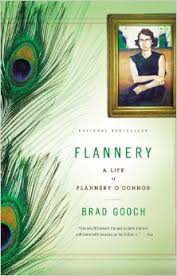 Flannery: A Life of Flannery O’Connor
Flannery: A Life of Flannery O’Connor
by Brad Gooch
Little Brown, 448 pages, $30.
SHE HATED the work of Truman Capote, Tennessee Williams, and Carson McCullers (Clock Without Hands was “the worst book I’ve ever read”). The sort of book she gave close friends was Romano Guardini’s The Lord, or Thomas Merton’s The Seven Storey Mountain, or Teilhard de Chardin’s The Phenomenon of Man. What she read every night in bed before turning out the light was Thomas Aquinas—surely one reason she called herself a “thirteenth century soul.” When Mary McCarthy (the “Big Intellectual”) admired the Eucharist as a symbol, she famously said, “Well, if it’s a symbol, to hell with it.”
She was also the only child of a prominent Savannah family with a mansion in Milledgeville, Georgia; a woman who appreciated Katherine Anne Porter’s “social grace” for inquiring about a pet chicken of hers that Porter had encountered on a visit two years before. She had piercing blue eyes and was devoid of self-pity. She and her mother Regina were both strong Southern women for whom the term “steel magnolias” does not do justice. “Steel girders” would be more like it—all under the guise of the ultimate hard surface: Southern manners. She was also as competitive as any writer—McCullers claimed she stole material from Member of the Wedding, and this biography points out things she lifted from Faulkner—and as ambitious. Taken up early on by literary big brothers such as Paul Engle, John Crowe Ransom, and Robert Lowell, she was the epitome of the MFA experience, notably at Iowa just after World War II, when everyone still met in Quonset huts.








